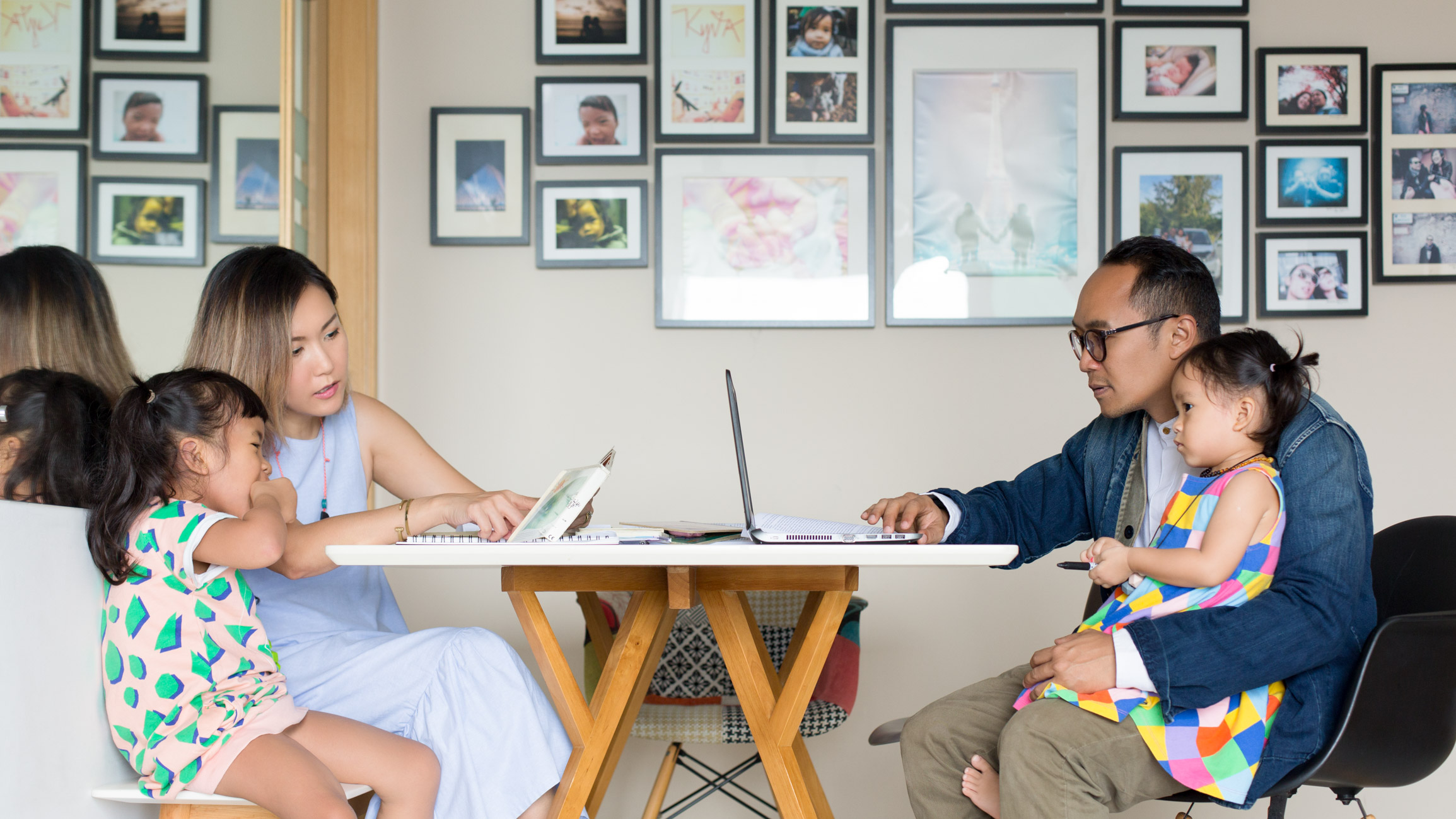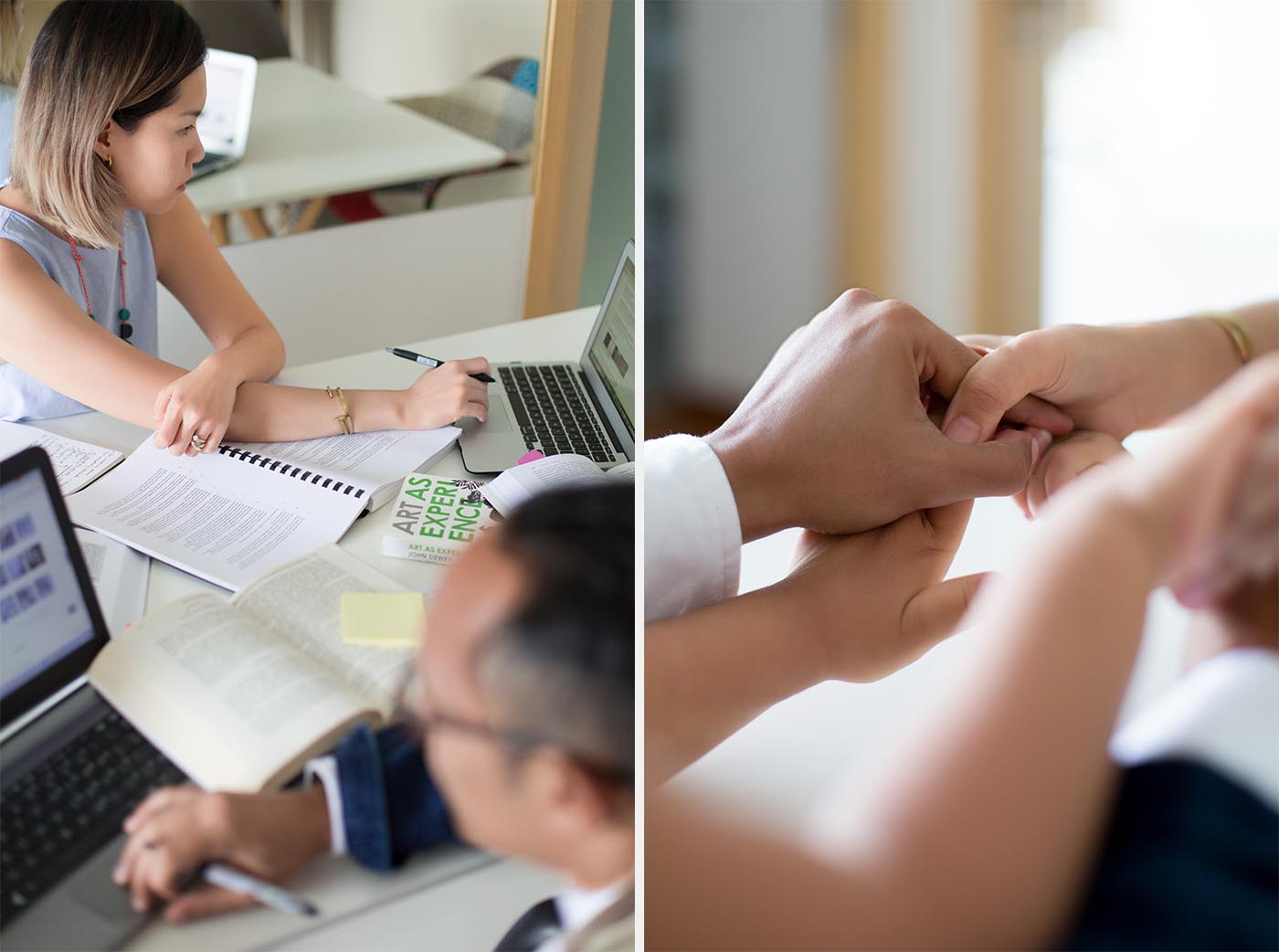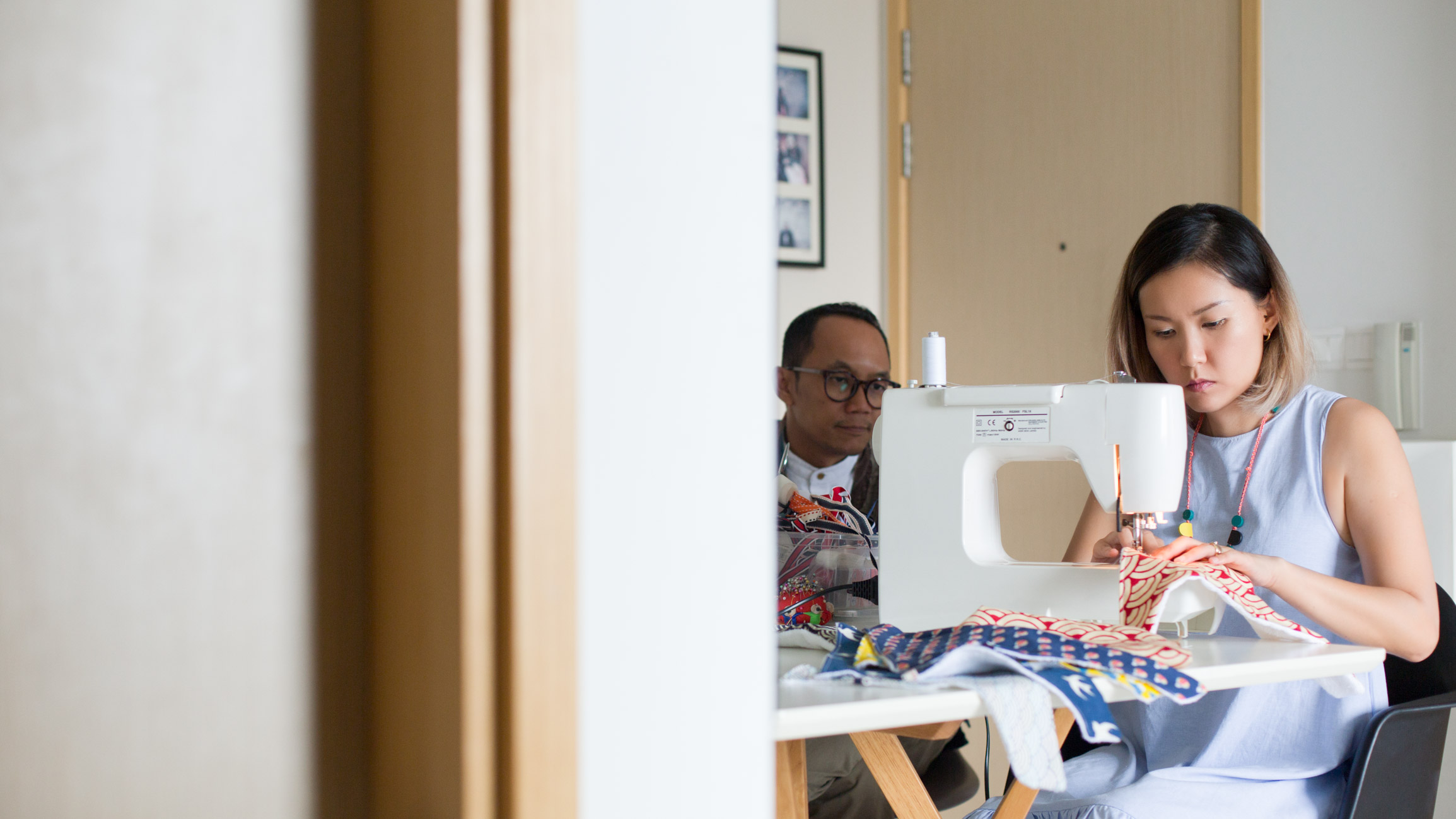UOB One Account x Shentonista — Supporting Roles


Khairyl and Magdelene, Teachers.
Khairyl: Jacket from Kapital, shirt from ILU, pants from Visvim.
Magdelene: Dress from Zara, necklace from Cotton On Kids, Bracelets from Stale & Co. and The Mindful Company
Khairyl and Magdelene met 13 years ago, about the same length of time that they’ve been teachers—Khairyl, at a secondary school, and Magdelene at a primary school. They might be better known as former members of local indie band The Great Spy Experiment, which disbanded in 2015, and while Khairyl still plays in another band called Riot !n Magenta, most of their time is devoted to work or to the care of their two young daughters. The two met while training in the National Institute of Education, and tell us it’s been one unexpected journey since. But few things come with more ups and downs than the challenges of parenthood or, indeed, being the leading figures for the hundreds of students they’ve helped to educate and inspire in the span of their careers. We paid the couple a visit in their home—where they sometimes find themselves poring over scripts and exam papers from school—and found out that there’s more to teaching than we think.

Why did you guys decide to become teachers?
Khairyl (K): When I was young I was fortunate enough to have great teachers. They inspired me and I knew that if I was to make any change it had to happen from the inside. So I decided to try teaching and I ended up actually really liking it. I think the passion comes from seeing the change in the kids that you teach. Most of the time the change is never immediate, but you’ll be surprised by how many students come back during Teacher’s Day. That’s the most rewarding part.
Magdelene (M): I’ve been teaching for 13 years. I really love kids and children. When I first started they gave me a Primary One class to teach. You feel that these young children really need you—it was very shiok (enjoyable). I’m more of the nurturing sort and I tend to mother them. I like watching the children grow, and they still come back to visit even when they’re in polytechnic and junior college.
What’s a typical day of work like?
M: I usually wake up at 530AM because my school’s quite far away. Work starts the moment you enter the school gate—because they’re such small kids, you have to watch out for things like their safety. I teach art, and though we get half-hour breaks to eat, we often have to stay behind to make sure each class cleans up before I can set up for the next one to come in right after. I teach 18 classes of 40 students, so it’s a mad rush starting from 7AM till the students leave school around 130PM. After that we’re involved in department meetings or co-curricular activities, and art teachers are usually also asked to help in sideline projects like school publications, department newsletters, play backdrops, etc.
K: I’m just fortunate that my school’s near so I spend less time travelling. I’m in charge of rugby for the school, so on average I leave around 5–6PM. Sometimes the boys get injured during competition and we’ll have to send them to the hospital and make sure they’re okay till their parents come over. This can go up till 10PM at night. We also bring work home to mark, set exam papers, and aside from that there’s lesson planning and stuff like Meet-The-Parents sessions.

What keeps you going, then?
K: You’ve got to have the passion. I’m not saying it’s not painful, but once you know why you’re doing this, it’s less painful!
M: We teach pretty much the same content each year, but every year we get a different group of children and they react to the same thing differently. It’s quite interesting to see how different groups of students deal with different mediums when they come in.
How would you say that the students or the subjects are different from before?
M: Craft is dying and kids are less tactile—they want to go the computer lab, and be in an air-conditioned room. Nowadays, kids are introduced to Adobe Photoshop in Primary One; they learn coding in Secondary school.
K: The landscape has become very different. But what’s cool is that I think schools are now more open to children with special needs, and they have special arrangements. On a management front it can be challenging at times because we’re not formally trained, but we do our best to teach and accommodate.
Do you have a role model when it comes to hard work?
K: I was a wild child, lah, in polytechnic. Iskandar Jalil, the potter, was my teacher, and I’d worked on some pots till 10PM at night but the next morning I found them all on the ground—he’d thrown all my pots out of the window. But the key takeaway was that I could do better, and that I was worth more than that. I met him again last year at his exhibition and he still remembers that he threw my pots away. Come to think of it, the ones who really moulded us were the ones who were the hardest on us.
M: My role model is my mum. She worked really hard to get a scholarship to study fashion, and the arts wasn’t a recognised subject then but she insisted on doing it. She always tried to be creative and innovative in terms of design—to me, that’s quite an inspiration, lah. She’s still very different, up till today. I’ve never seen anyone as crazy about (the Kpop star) G-Dragon as her.

Any advice you want to give to anyone who wants to become a teacher?
K: It’s a very personal career; you have to welcome these kids into your heart. You only have one heart but there’re hundreds of students; out of the hundreds, maybe ten will make you smile while the rest will break your heart. In that sense, you need to have patience, tolerance, and a lot of love to give.
What’s something about your job that you think people have misconceptions about?
K: A lot of my friends think June holidays mean the whole month of June but no, the first three weeks we’re pretty much in school. There’s this thing called Protected Time where you’re supposed to have at least two weeks of break during June, but more often than not, we have other commitments like camps or CCA, or preparation for the next term.
M: I guess if you’re a teacher you’ll never get to see the sakura in Japan, lah.
K: Or go to Glastonbury, or Fuji Rock Festival. For music fans like us, that’s what we sacrifice, lah.
M: I also feel that people become very judgmental when they know we’re teachers. When we go out for dinner and we mention “This student…” we see the people from the next table lean over to try to hear what we’re talking about. Sometimes they give us a look like, “Why is this teacher dressed like that?” or “Why is her hair like that?”
Why do you continue to do what you’re doing?
K: Pay bills, lah! (laughs) But really, it’s never a fixed day. Every student learns differently so the challenge there is quite fun.
M: I enjoy the sharing of knowledge, the constant learning. There’s always a new way of innovating with the medium, a different way of teaching or interacting with students.

What about some of the challenges when it comes to teaching?
K: It’s draining, and it’s also heartbreaking when we cannot get through to certain students. With some parents, they’re also like, “My son is in your care, if anything goes wrong it’s your fault.”
M: It’s very mentally breaking. You ask yourself why the method you used didn’t work, and you keep thinking that there has to be a way.
Do you have one really terribly heartbreaking episode?
K: I had this boy who could not get along with any of the teachers, but he could relate to me because he was also into music and skateboarding. We always talked about his interests and we built up the trust from there. But eventually, because of problems outside of school, he had to drop out to go to a boy’s home. I felt like I’d almost gotten to him, but he disappeared and became uncontactable. That was really difficult for me, because I knew he had the potential to do well for himself.
M: You try to reach out but there’re other factors that affect you. Then there are kids who bring their stories from home—the kids who finish school at 130PM but have to wait in the general office till 6PM to wait for their mother to pick them up; kids who’ve been abused.
How do you replenish your energy then?
K: I guess it helps that we can share our stories together. We try to turn it around by making it into something positive, for example, by giving, especially with Kbibs.
Can you tell us about Kbibs?
M: Our elder daughter, Kyra, has a rare genetic disorder called macrocephaly-capillary malformation which affects her muscles and motor skills, and because of this she still has drooling issues. Kbibs is named after her. I was looking for bibs for her but the ones available were either not very nice or too small because they’re generally for kids aged 2 years and below. So I started buying fabric and making these bibs for her. In the hospital I’d see older kids with nappy cloths tied around their necks because their parents couldn’t find big-enough bibs too, and so I started making bibs for other children. All the sales go into Kyra’s account. It helps because no insurance company wants to cover her, because she was a premature baby and her condition is so rare; she’s the only one in Singapore. There’re only three cases in Asia and 150 in the world.

What’s something that you think you should be doing more of, or you wish you had more time to do?
K: Self-investment. I think something you get too caught up with paying bills, or just responsibilities in general, and you forget about yourself. When I see all the crazy stuff Mag’s doing, I worry for her. I always tell her to go and take a trip with her girlfriends but she doesn’t want to. It’s too much for a Malay boy to see a hardworking person under the same roof. It’s not supposed to be this way. (laughs) There’re so many other aspects: to be a better husband and father; to go do my masters; and learn how to cook.
M: I’d like to be able to travel more. I think with each trip you learn something new and you get constantly inspired. With Kyra, there’re a lot places we have to cross out because they’re not wheelchair-friendly and that’s the biggest issue. I’d also like to take up proper sewing classes.
What other steps do you all take to save for the family? Any tips you can share?
K: Be prudent, spend what you need. It’s about being aware of what products are out there, and which suits your lifestyle best, based on what your future plans are—for example, if you’re going to get married, or buy a house. Mag is the Chinese wife that I need, I always rely on her “abacus” when it comes to finances. She’s more astute than me.
Is there anything that you guys are saving up for at the moment?
M: Our dream is to have a room that’s specially tailored to Kyra’s needs; one that comes with a ramp and an ensuite toilet with handles so she can take a shower by herself. She uses a wheelchair but you don’t see it in the house, because we don’t have space. We really want a place where she can manoeuvre independently by herself.

This is a Shentonista project for the UOB One Account, which works just as hard as you. Find out more here.
Like this? Share it.
What others are saying
There are no comments yet.
Leave a Reply